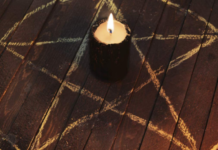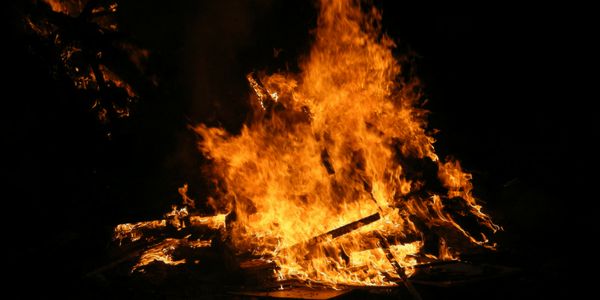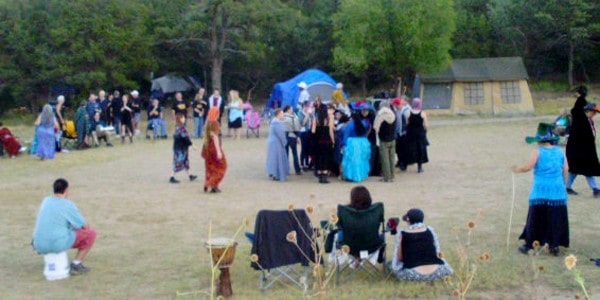 This is my fourth time attending the Magical Mountain Mabon festival, and I am excited to return. This is the festival that defines the Land of Enchantment for me.
This is my fourth time attending the Magical Mountain Mabon festival, and I am excited to return. This is the festival that defines the Land of Enchantment for me.
For 15 years the Magical Mountain Mabon festival has made its home here in the mountains east of Albuquerque. T. Hunter (my partner), our dog, and I all awaited our weekend in the woods away from the city and amongst the witches. In our packed van, I miss the turn (not for the first time either) and have to double back. I recall the familiar aspects — friends, the pancake breakfast, the Wild Hunt in all its twilit glory, and the new, sold out campground, and, of course, Selena Fox, leading a discussion, and the improvisational music around the fire — just before pulling up at the gate and hopping out to hail the camp.
Magical Mountain Mabon is located in Cibola National Forest, Cedro Campground, and holds 250 attendants, half of which are new participants this year. The new online registration seems to have reached more people than in years past, and this creates a packed and excited atmosphere.
When we arrive at 10 pm Thursday night, the campsite is already at half capacity, and we take about an hour to find a spot to camp. A moonless sky plays stage for the Milky Way and a multitude of other twinkling dots in space. Drums thud, and a cowbell chimes around the fire on the west hill. Juniper, cedar, and pine scented the air, along with the crispness typical of the mountains in the summer. RVs and cars line the two roads north of the main ritual grounds. Tents and easy-ups populate the grassy valley and the hilly forest. Many camps shone with LEDs, human constellations on the landscape mimicking the sky. After wrestling with the tent, we soon fall asleep to the sound of the drum circle and a warm,dry night, knowing those stars are out there.
Queer Life Transitions Panel
Friday is fully booked. T. and I both sit on panel entitled Queer Life Transitions. This is five-person panel full of philosophy, identity politics, anecdotes and musings and centred on the shared sense of liminality in Pagan and queer lives and the unique life passages queer Pagans may experience. Roughly 20 people attend this discussion including the moderator, Gaian Isis, the panellists, and Selena Fox, the weekend’s guest presenter. Audience participation is scattered throughout and my favourite question is R’s who, as a local priestess, wonders if there is some way to make a rite of community acceptance for a queer person, if they request such support in their transitions. Panellists each contribute: archways, epic re-enactments of overcoming obstacles or journeys, and welcoming arms all feature as brilliant ideas. Excellent post-discussion follows immediately and throughout the weekend. Later, Gaian Isis says the discussions amongst the participants and the workshops were a highlight of the weekend, and I must agree.
Changing Life, Changing Identity
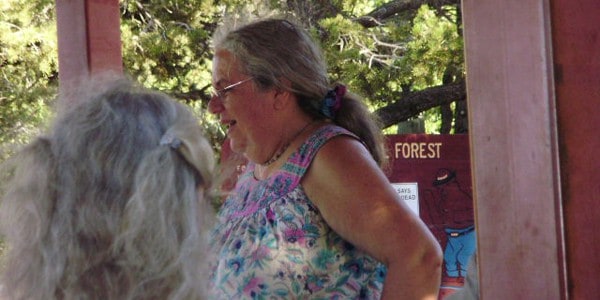
Shortly after the discussion ended, we huddled in for Selena Fox’s 11 am Changing Life, Changing Identity. Selena Fox is a founder of Circle Sanctuary, as well as an author and musician. Her lifetime as a Wiccan priestess, activist, psychotherapist, writer, teacher, and ritual performance artist makes her an energetic and comfortable guest for the weekend. Fox’s style is easy-going and subtle, with occasional dramatic intonations.
She captures the audience’s interest and attention well as she discusses four kinds of life transitions, five elementally-based ways to approach these changes, and the need for ritual and meditation during these transitions. Fox also includes meditation for helping in making choices which involves a crossroads and noting your body’s response to various paths or outcomes. She impresses upon us the understanding that we are “works in progress” and that we are “art projects.” This allows change and adaptability in our lives. These times must be acknowledged and noted through some kind of ritual.
 Fox calls forward any audience members who have served in the US armed forces. Fourteen veterans and active duty soldiers receive a Pagan Service Award — complete with paperwork — to wear on their uniforms. They look proud and I support their hard work as members of their community. When Fox asks if the experience feels good or weird, they all reply “good,” and this serves as an example of the importance of ritual awards within modern Pagan community.
Fox calls forward any audience members who have served in the US armed forces. Fourteen veterans and active duty soldiers receive a Pagan Service Award — complete with paperwork — to wear on their uniforms. They look proud and I support their hard work as members of their community. When Fox asks if the experience feels good or weird, they all reply “good,” and this serves as an example of the importance of ritual awards within modern Pagan community.
As well as achievements, Fox talks about trauma and change as a life passage. She condones the use of pop-culture Pagan icons, such as Xena: Warrior Princess, to encourage mythic strength. Visualization of symbols such as crossroads or a passcode or a key, or butterfly are mentioned, and when a moth flies through the workshop, Fox laughs at nature’s sense of appropriateness. This is a woman deep at ease with herself and the natural world. Both my partner and I enjoy that her chants include phrases like “peace” and “‘name-of-participant be well.” It ensures folks will join in and sing along with the magically interactive moments.
Entering the ritual field
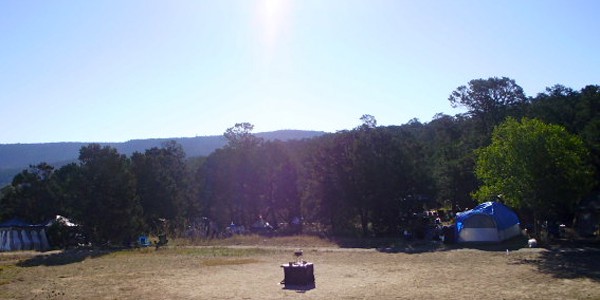
When the Friday sky darkens and the air cools, campers begin their descent into the ritual field. Entering from the eastern end of the circle, all participants pass through sage smoke. I smell myrrh as well. We gather ourselves into a egg-shaped arrangement, and the high priestess and priest cast the circle. The high priest calls quarters through a mediation of our bodies containing each element. While this practise is not novel, I always enjoy it’s use in a large public ritual, since it personalizes the experiences while cutting down on long castings.
The Lord and Lady of the Harvest are invoked and the ritual theatre begins. A human comes to the Lady for help with food throughout the winter. The Lady and Lord intervene by asking four clans, Birds, Snakes, Fish and Wolves to assist. Each agree to help, but warn, “It will not be easy.” In return, the Human Clan must also give up one of their own.
In the twilight, a bearded youth in deer cape with a crown of antlers is presented. All the Hunters stir in the circle, and when the Stag King dashes off, the chase is on. Howling, smoke, and thudding steps filled the air as the hunters and the hunted staggered through the forest ringing the ritual field. Epic moments later the Stag King is brought down and buried in the “ground” under a dark sheet.
A Spiral Dance begins, and we weave labyrinths round those in the centre who remain seated. After the Hunt we write personal sacrifices on parchment slips to burn in a cauldron. Once both acts are complete, the air is laden with magick. We can feel the web of the circle and the power of the symbolic acts, both small and personal, as well as large and theatrical. In conjunct, we have all done work on our personal paths, while reaffirming the strength we gain from community. After a round of vegetables, meat, and various meads are administered with gleeful “may you never hunger” and “may you never thirst” all deities and elemental are released, the circle disbands, though drumming and song soon rise from a nearby fire.
Friday night bardic and drum circles
We travel to the east fire pit to enjoy the bardic circle. This is a sweet and powerful tradition at Magical Mountain Mabon. A fire ringed with seats, logs, and blankets fills with families and pets, and all manner of folk remind me of so many ancient fires where people gathered to share stories, song, poetry, folk tales, jokes, and fire dancing — all are present with passion and celebration.
A few children tell stories, I offer a devotional prayer, and we hear many folk songs and even bawdy drinking songs. But even before the bardic circle finishes, we hear the stirrings of the drum circle high on the hill opposite. We decide to make the hike back to the tent for our drums and join the growing fray. Beautifully adorned and bedecked silhouettes circle round in rhythm. I dance, drum, and sing. After hiking our gear back to the tent, T and I sit to watch the stars together before settling in for the night.
Pagan Pride Day Breakfast
The Pagan Pride Day Pancake Breakfast is a great idea; a $7 donation gets you pancakes, green chile turkey sausage, coffee, and orange juice. Sadly, it sells out quickly, and was gone by 9 am, when we arrive. It turns out they still have plenty of coffee, and in a short time they find some more pancake batter and hot flapjacks are grilling. The turkey green chile sausages really aree gone, though I manage to get the recipe from the chef, and can’t wait to whip em up! Various conversations over breakfast manifest. We ended up talking futurism, magical technicalities, and writing with R and J. We carry on a lazy morning while the Chamisa Local Council, the Magical Mountain Mabon hosts and planners, have their annual meeting.
Pagan Death Passages
Later that Saturday, Selena Fox presents Pagan Death Passages. We open with a conversation with a stranger about our wishes for after death. I share my wishes for my body to be donated to science with an older Wiccan who wishes for a green burial, perhaps with a tree above to shade future generations.
Fox impresses upon us the importance of thinking about and possibly planning our death logistics, so we are honoured as we wished, instead of having next of kin who may not know one’s wishes. In addition, Selena shares four categories of Death Passages: 1. Dying Support, 2. Time of Death, 3. After Death, and 4. Grief Journey. Each category has associated rituals, as well as mundane and emotional tips for supporting and navigating the dying, their deaths, and ourselves. I love Fox’s suggestion that Mabon and Samhain are ideal times to prepare wills, or change next of kin status as part of our ancestral work.
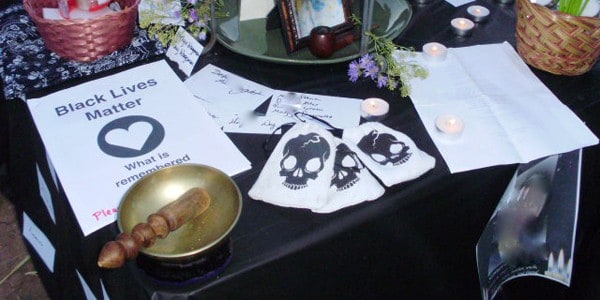
On Saturday night, Selena Fox leads ritual. We again gather on a circle and use our voices to call the elements in a simple formula. We call our deities, then around the cauldron of incense, we write names.
Fox instructs us to write names and bring mementos of our beloved dead. Personal tokens like a tobacco pipe and photographs are interspersed between the index cards of names. Gaian Isis brings the names of those involved in the #blacklivematter movement, also honouring a list of trans people murdered in the past year. We light candles for the dead and incense, too. Tears begin to sparkle on cheeks, as murmured words and sombre tones fill the air.
When we return to the circle, Fox bids us to name out loud our beloved dead. We then name the dead of the larger community, and lastly name those dead forerunners and pioneers of witchcraft. Names like Aleister Crowley, and Raymond Buckland are clear, as well Marija Gimbutas, Margot Adler, and Scott Cunningham, alongside many I cannot not hear or recognize. William Shakespeare, the Bard himself, is named, as well as Terry Pratchett. Under the new moon sky, the air fills with these enigmatic shades.
Then, any who need support for their grief enter the centre of the circle, while others hug them, or lay on hands. Others, myself included, chant from the outmost circle, creating a circle of protection for the grief to move through people. Once the circle is closed, like those mythic witches, Fox dashes off in the middle of the night to catch her 3 am flight to Chicago, leaving us to drum the night away.
Saturday night drum circle
Truly, the music during the drum circles captivate the night-time revellers. Each night sees a handful of drummers and percussionists, dancers of all kinds and singers kindle the fire — and Mabon fires are all about chanting.
The Crow Women, who shared their magick in the Circle of Remembrance, surround the fire with their voices. A few favourite chants of mine include “We will Kindle the Fire,” and “Dark Goddess Medley.” I am happy to say that I’ve been around these fires enough to learn and sing in with many songs and it amplifies the fore circle to have so many layers of music and movement.
Bystanders share mead, and other libations. Conversations, laughter, and mirth follow you everywhere the fire’s light touches. Straying into the dark a bit, other fires and camps can be seen. Laughter floats in the air from every direction. T and I leave the fire shortly before 1 am and drift off to sleep, well worn from the day’s activities, and resting in preparation for the round table we will lead Sunday morning.
Cultural Appropriation within Paganism
I wake early to prepare for my panel, Cultural Appropriation within Paganism. The turnout is an impressive 16 people. For a 9 am panel, on the last Sunday morning of the festival, I coudln’t have asked for better. We unpack the overculture’s privileges that follow in our magical practice. Not everyone sees eye to eye, but all remain civil and inquisitive. Afterwards, many of us feel we should continue more discussion, and encourage more dialogue not only amongst ourselves, but also with other faith communities.
Closing ritual
The closing ritual is preluded by a short announcement call. Some of CLC leaders announce that they are available to discuss with folks affected by an issue from around the fire that occurred after my partner and I had gone to bed; details are not shared. I respect the manner in which leadership takes account and creates space to heal without disclosing details to those not involved.
We then circle up in a short rite focused on turning toward winter and the darker portions of the Wheel of the Year. We release the deities invoked and the elements called, and say goodbye to the land itself.
I feel a sadness.
We are all leaving this space we made sacred, this bit of Gaia that enchanted us for days. But even in that leaving, I know the Earth and we, as a community, are better off for even having this time together. Many of us will gather around the Albuquerque areas in the coming months for Samhain and other celebrations. After, the closing circle, Mische — a 50 year-old reveller from Albuquerque in pink, white and lace — told me “I feel complete. Very content and rejuvenated and full of gratitude.”
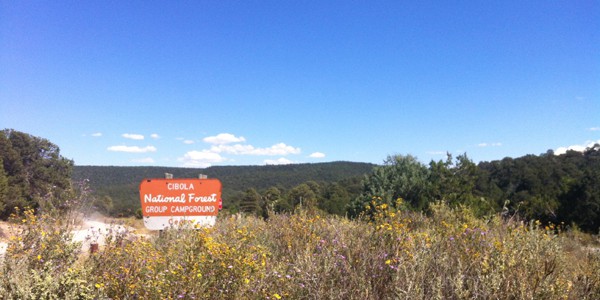
Reflections
This is a small festival in the scale of things. Selling out all 250 spots is an achievement, but it also seems to surprise many folks. There is talk about moving the festival to accommodate more people, but nothing beyond exploration at this time. Ray, in his fifties, remarks that this festival is “about community more than it is magick or ritual.” This sense of community is achieved through a smaller festival and Ray also mentions that the Magical Mountain Mabon festival “is no Pantheacon” and it seems a fine thing to have a small gathering.
Gaian Isis, one of this year’s co-ordinators, speaks of a “community focused on service” as a strength, and I am reminded of the Mabon book I recently reviewed.1 Two of the main focuses of the holiday were, according to Rajchel, community and service. The Magical Mountain Mabon festival delivers these qualities as much as it honours the harvest.
I have a suspicion that the real magick at Mabon is subtle, and playing the long game over the course of years. The deeper you participate, the more you are connected and the more you return, the deeper the magick. We will sing more songs together and we will light more fires. We will watch more stars.
Image credit: T Hunter


